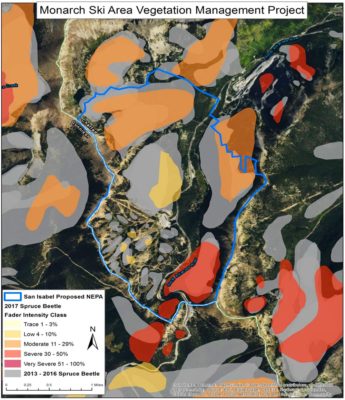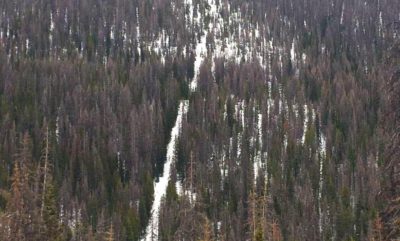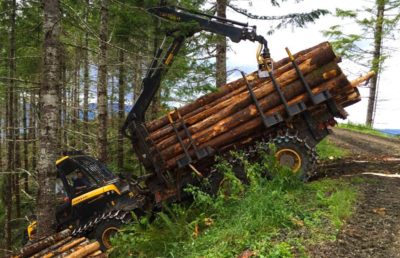Spearheaded by the U.S. Forest Service, the Monarch Pass Forest and Watershed Health Project is addressing the spruce-beetle infestation and subsequent die-off of trees in the Monarch Pass area.
As outlined by U.S. Forest Service Silviculturist Alex Rudney, the purpose of the project is to:
• Reduce beetle infestation.
• Improve forest resiliency to infestation.
• Reduce fuel loading to minimize the potential for and impacts of forest fire.
• Provide for firefighter and public safety.
• Improve watershed health.
• Protect infrastructure, including power transmission lines.
• Improve aquatic ecosystem health.

This map shows the Monarch Pass Forest and Watershed Health Project outlined in blue. Shaded areas show spruce beetle activity in the last four years (courtesy image).
“We are trying to gather all of our partners (and) look for funding to help move this project forward,” said Chelsey Nutter, projects manager with the Upper Arkansas Water Conservancy District, which is a partner in the project.
Additional partners include the Arkansas River Watershed Collaborative, Trout Unlimited and Colorado Springs Utilities. The Upper Ark district has committed $48,000 to the project, Nutter said, while Colorado Springs Utilities has committed $25,000, and Trout Unlimited has committed $13,000. Additional matching funds from local governments and other entities will help expedite the project.
Nutter said the total project cost is estimated at $1.5 million and that she is preparing a request for a $400,000 grant from the Colorado Water Supply Reserve Fund, which will require matching funds of $200,000.
She is also requesting $38,000 from the Arkansas Basin Roundtable, and of the $200,000 needed to secure the Water Reserve Fund grant, current commitments total approximately $123,000.
Nutter noted multiple project benefits to local communities, including:
• Protection of public water supplies.
• Mitigation of catastrophic erosion in the event of a forest fire.
• Protection of water, power and transportation infrastructure.
• Economic development.

Dead and dying spruce trees dominate the forest near Monarch Pass. The U.S. Forest Service and its partners are working to minimize fire risk and protect local water resources through the Monarch Pass Forest and Watershed Health Project (courtesy photo).
Given the heightened threat of forest fires created by drought conditions combined with beetle-kill trees, Rudney expressed a sense of urgency to keep the project moving forward.
He noted how much the forest has changed in the past three to four years. “It’s gone from a real green forest to a lot of dead trees … about 90 percent mortality of the spruce trees 5 inches (diameter) and bigger across the whole entire project area.”
The early stages of the project included preventative spraying of select trees beginning in 2013, removal of dead trees posing threats to power lines and public safety, and contracting with Monarch Mountain resort for beetle-kill remediation at the ski area.
“We’ll be cutting dead trees in the ski area by this fall,” Rudney said. “The next step in the project’s going to be a timber sale … on both sides of Highway 50. And then we get to this problem. The slopes across from the ski area are very steep, and the ability to do vegetation management in Colorado is very limited and very expensive on steep slopes.”
Rudney said slopes greater than 40 percent constitute about 600 acres of the project area on the south side of U.S. Highway 50. “Once you’re on slopes greater than 40 percent, ground-based equipment causes resource damage,” especially when tires begin to spin and dig into the soil.
Rudney said the plan for this area is to use new “steep-slope cut-to-length logging” equipment designed to operate on slopes up to 70 percent. This new equipment uses tracks and a winch tethered to the top of the treatment area to operate on steep slopes.

This steep-slope cut-to-length equipment uses tracks and a winch to perform logging operations on slopes as steep as 70 percent. The U.S. Forest Service proposes to use this equipment for the first time in Colorado to harvest beetle-kill timber that would otherwise contribute to heightened risk of forest fire in the Monarch Pass area (courtesy photo).
As each “feller-buncher” machine descends the slope and harvests trees, it leaves a bed of slash in front of itself, further protecting the soil in the machine’s path, Rudney said. The feller-buncher can treat a 60-foot-wide swath of forest, leaving behind stacks of logs cut to standard sawmill lengths.
Next, Rudney said, a machine called a “forwarder” descends along the path followed by the feller-buncher and “picks up the logs and brings them to the top of the slope.”
Compared to traditional steep-slope logging using cable systems or helicopters, this new equipment reduces the need for roads, reduces soil disturbance, reduces visual impacts, improves worker safety and costs less.
“If we get a fire start in some of these beetle-kill areas … we’re not going to put people in there to put those fires out.” The fuel is so dry and there’s so much fuel, Rudney said, that firefighting efforts have been “very ineffective. … So what we’re trying to do up here is reduce fuel loading but also make it possible to … get in and fight these fires.”
Rudney said this steep-slope logging equipment is not currently available in Colorado. “This is a demonstration project, and there’s some cost associated with it” because equipment and operators would have to be brought in from the West Coast.
The hope, he said, is that this project will demonstrate a cost-effective method for addressing fuel loading on steep slopes and encourage Colorado logging businesses to acquire this technology, thereby spurring economic development.
From a watershed perspective, Rudney said the project would also address “significant erosion going on from water coming off of Highway 50 and from some old gravel pits,” which causes “a lot of sedimentation in the South Arkansas River” that is affecting downstream water users.
He said the plan is to use revenue from the project’s timber sales to help fund these watershed health projects.
“Most of our most critical water resources have these steep slopes around them,” said Nutter. “We need something that can get up on these steep slopes” to help minimize the adverse effects of potential forest fires. The hope is to line up sufficient matching funds to be able to bring in the steep-slope equipment and put it to use by the fall of 2019. “That’s our priority.”










Recent Comments